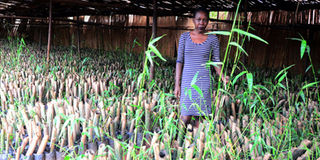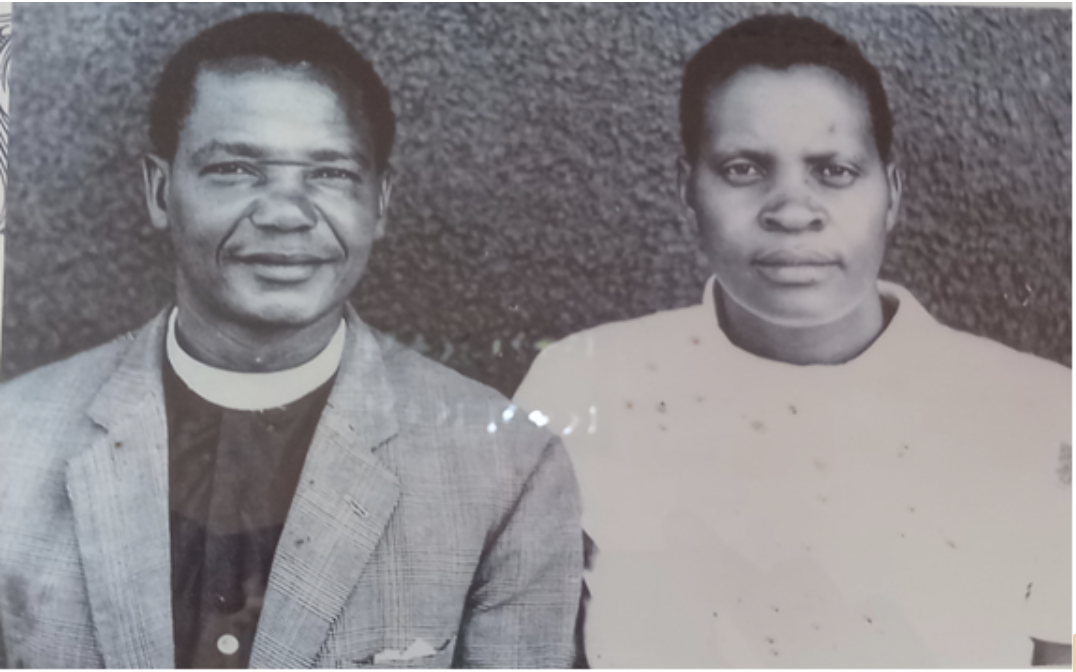Government resorts to bamboo to reverse deforestation

Inspection. Ms Divine Nabaweesi, one of the bamboo farmers, inspects of her bamboo nursery bed. Government now wants the country to adopt bamboo planting to save the disappearing forest cover and avert climate change effects. PHOTO BY MICHAEL KAKUMIRIZI
What you need to know:
Concern. Ms Mary Gorreti Kitutu, the Minister of State for Environment, says her ministry will, among other things, license charcoal burning communities and have them grow giant bamboo trees for their businesses to save the remaining trees, writes Arthur Arnold Wadero
Government, through the water and environment sector, has moved to embark on a mass bamboo planting exercise to tame the high depleting forest cover and also restore the serene environment radiating from forests.
The strategy came to light during the release of the 11th Water and Environment Sector Report of the Financial Year 2017//2018 in Kampala.
The report provides evidence on investments, targets, achievements, and challenges for the sector during the Financial Year 2017/2018.
The report captures a deploring decline in the country’s forest cover sinking from 24 per cent in the 1990s to 12.4 per cent in 2015 alone, a rate said to be one of the highest in the world.
“Deforestation is still a major challenge, with decline of forest cover from 24 per cent in 1990 to 12.4 per cent in 2015. Uganda has an average annual loss of natural forest of two per cent per annum, one of the highest in the world,” the report notes.
The greatest threat to Uganda’s forests stem from the charcoal burning community, something the State Minister for Water and Environment, Ms Mary Gorreti Kitutu, has since moved to curb.
Ms Kitutu says her ministry will, among other things, license charcoal burning communities and have them grow giant bamboo trees for their businesses to save the remaining trees.
“I have already met the National Charcoal Burning Association and we are saying it should take on planting bamboo,” Ms Kitutu says.
Use of bamboo
She says the same giant trees can also be used for timber, paper processing and making clothes as it is the case in China.
“For the first time in Uganda, we experienced a heat wave and I am warning all Ugandans [that] these are signs that we are now also heading towards the threat of the advancing desert. And the only remedy is planting trees,” she adds.
She says: “By April next year, we should have planted 500 million tress.”
The total financing of the sector, including ongoing and offset resources, was approximately Shs939.12 billion, having been appropriated by Parliament for the Ministry of Water and Environment and all its agencies.
The internally generated funds approved by Parliament as Appropriation in Aid (AIA), was Shs560 billion, representing 29 per cent of the sector’s budget.
Civil Society Organisations active in environment and natural resources reported a contribution of $4,317,560 (about Shs16 billion). These represented an increase of 57 per cent from the previous year.
Challenges
Mr Alfred Okot Okidi, the Permanent Secretary in the Ministry of Water and Environment, says: “There is a major challenge of inadequate funding [because] our resource envelope is small and this affects the fulfillment of core functions.”
He adds: “The targets under the Strategic Sector Investment Plan and Presidential Directives (like the one water source per village) are unlikely to be met.”
He adds that land acquisition and easement is another challenge because getting people to allow pipes and where to set up tanks is always a problem and it has caused delays in a number of places, including the facilities for water production.
Mr Okidi said: “At the moment, we have close to 20,000 villages without clean and safe water sources in the country. We can no longer rely on boreholes because they are not reliable. So, we are looking at alternative solutions based on solar to implement this, but they are more costly.”
Achievements
On the flipside of the performance-card are a number key progress registered by the sector in the preceding financial year.
The weather forecast radar was successfully installed in Kigungu-Entebbe. The procurement of the second radar (Mwizi-Mbarara) is in advanced stages, with equipment in shipment from Germany.
Performance of manual weather station was at 60 per cent, automated weather stations 93 per cent and rainfall stations 40 per cent.
Mr Okidi also said: “The ministry has completed the construction of four medium scale irrigation schemes at Olweny in Lira, Agoro in Lamwo, Mubuku I in Kasese and Doho in Butaleja, and also completed construction of 35 small scale irrigation schemes.”
The national standards recommend a pupil to stance ratio of 40:1 in schools. According to district reports, the national pupil to stance ratio reduced from 73:1 in 2017/18 to 71:1. Access to hand washing facilities in schools increased from 40 per cent in 2017/18 to 42per cent.
Future plan
Mr Okidi says his ministry is now advocating for a specific financial increase to be hinged on development purposes.
“We want a financial increase to be reinforced and be tied to development purposes. We have also negotiated with the African Development Bank to develop bulk supply systems that target rural areas through gravity flow schemes,” Mr Okidi says.
These will be in addition to the already existing ones, these will enable people to get access to clean water so that we move water from a reliable water sources over a distance of more than 100kms and along the distance, we keep on supplying.
Effects
In 1994, the wetland coverage was on surface area of Uganda was 15.6 per cent. However, this has been gradually reducing and is currently at 8.9 per cent. At least 148kms of critical wetlands were demarcated, while sanitation in rural areas reduced from 79 per cent in FY 2017/18 to 77.2 per cent.
As of June, the National Water and Sewerage Cooperation coverage in rural areas was estimated at 69 per cent, representing a decline from 70 per cent as of June 2018. The percentage of rural villages with safe water supply stagnated at 66 per cent.




